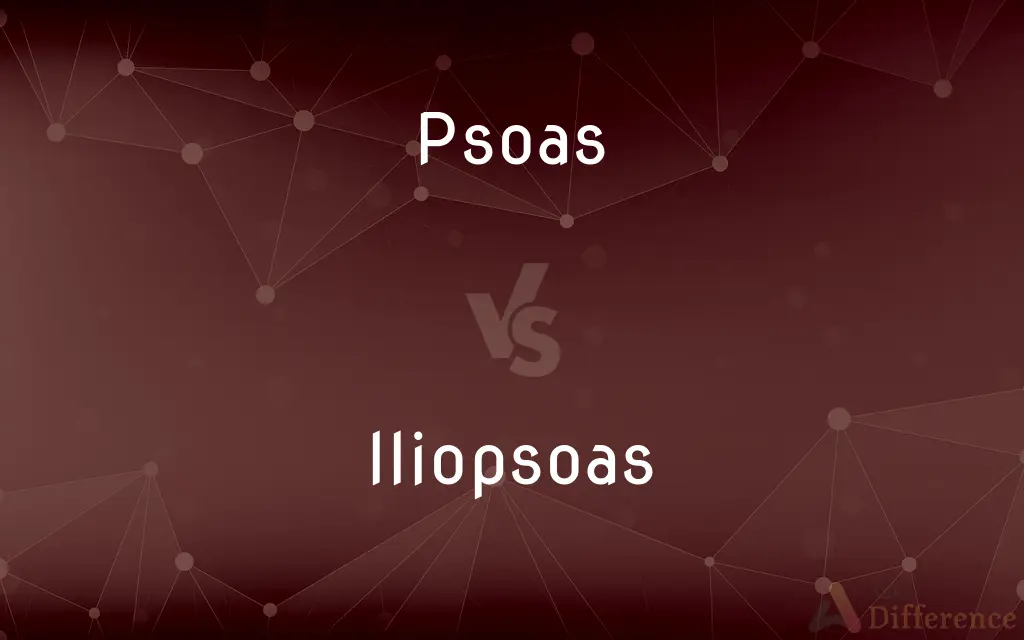Psoas vs. Iliopsoas — What's the Difference?
By Tayyaba Rehman & Maham Liaqat — Updated on April 1, 2024
The psoas is a major muscle that connects the lumbar spine to the femur, whereas the iliopsoas is a group including both the psoas major and the iliacus muscles.

Difference Between Psoas and Iliopsoas
Table of Contents
ADVERTISEMENT
Key Differences
The psoas major, often simply referred to as the psoas, is a deep-seated muscle that extends from the lumbar vertebrae to the femur. It plays a crucial role in flexing the hip joint and stabilizing the lower back. On the other hand, the iliopsoas refers to the combined group of the psoas major and the iliacus muscles. These two muscles work in concert to perform similar functions, but the iliacus originates from the iliac fossa of the pelvis, adding an extra layer of support for hip flexion and pelvic stability.
The psoas is known for its influence on posture and lower back health, as it helps maintain the spine's curvature. Whereas, the iliopsoas, due to the addition of the iliacus muscle, not only assists in maintaining posture but also has a more significant impact on hip movement, particularly in actions that require lifting the knee towards the chest.
In terms of anatomy, the psoas originates from the lumbar vertebrae and inserts into the lesser trochanter of the femur. Meanwhile, the iliopsoas, being a combination, includes the psoas major's origin and insertion points as well as those of the iliacus, which originates in the iliac fossa and joins the psoas major to insert into the lesser trochanter.
Issues related to the psoas muscle can lead to lower back pain, a common complaint among many people. The iliopsoas group, by extension, when tight or imbalanced, can contribute to a range of issues from lower back pain to hip and pelvic discomfort, underscoring the interconnected nature of these muscles and their functions.
Training and stretching the psoas muscle involve exercises that focus on the lower back and hips. However, targeting the iliopsoas requires a more holistic approach, incorporating movements that engage both the hip and the pelvic regions, reflecting the comprehensive function of the iliopsoas muscle group in body mechanics.
ADVERTISEMENT
Comparison Chart
Definition
A major muscle connecting the lumbar spine to the femur.
A muscle group consisting of the psoas major and iliacus muscles.
Main Function
Flexes the hip joint and stabilizes the lower back.
Flexes the hip joint and stabilizes the pelvis.
Origin
Lumbar vertebrae
Lumbar vertebrae and iliac fossa
Insertion
Lesser trochanter of the femur
Lesser trochanter of the femur
Associated Issues
Lower back pain
Lower back pain, hip, and pelvic discomfort
Compare with Definitions
Psoas
Muscle extending from the lumbar vertebrae to the femur.
The psoas is crucial for hip flexion and spinal stability.
Iliopsoas
Plays a significant role in hip and pelvic stability.
Strengthening the iliopsoas can improve athletic performance and mobility.
Psoas
Stretched and strengthened through specific exercises.
Lunges and leg lifts can effectively target the psoas for flexibility and strength.
Iliopsoas
Combination of the psoas major and iliacus muscles.
The iliopsoas is integral for hip flexion and pelvic balance.
Psoas
Influences posture and lower back health.
A strong psoas supports the lower spine, aiding in a better posture.
Iliopsoas
Critical for advanced movement and posture.
Proper iliopsoas function is essential for maintaining posture and facilitating complex movements.
Psoas
Involved in many movements and activities.
From walking to running, the psoas plays a key role in hip movement.
Iliopsoas
Can be the source of hip and pelvic discomfort.
Tight iliopsoas muscles may lead to discomfort and limited range of motion.
Psoas
Prone to tightness and imbalance.
Sedentary lifestyles often lead to a tight psoas, contributing to back pain.
Iliopsoas
Requires holistic training and stretching approaches.
Yoga and Pilates are effective in engaging and stretching the iliopsoas.
Psoas
The larger of two muscles that originate in the lower spine. This muscle flexes the hip. Also called psoas major.
Iliopsoas
The iliopsoas muscle (; from Latin: ile, lit. 'groin' and Ancient Greek: ψόᾱ, romanized: psóā, lit. 'muscles of the loins') refers to the joined psoas major and the iliacus muscles. The two muscles are separate in the abdomen, but usually merge in the thigh.
Psoas
The smaller of two muscles that originate in the lower spine. This muscle flexes the lower spine. Also called psoas minor.
Iliopsoas
(muscle) A compound muscle composed of the iliac and psoas muscles.
Look at those iliopsoases working!
Psoas
(anatomy) Either of two muscles, the psoas major and psoas minor, involved in flexion of the trunk.
Iliopsoas
The great flexor muscle of the hip joint, divisible into two parts, the iliac and great psoas, - often regarded as distinct muscles.
Psoas
An internal muscle arising from the lumbar vertebræ and inserted into the femur. In man there are usually two on each side, and the larger one, or great psoas, forms a part of the iliopsoas.
Psoas
Either of two muscles of the abdomen and pelvis that flex the trunk and rotate the thigh
Common Curiosities
What is the iliopsoas?
The iliopsoas refers to the combined group of the psoas major and iliacus muscles, playing a key role in hip flexion and pelvic stability.
Why is the psoas important?
The psoas is important for maintaining lower back stability, influencing posture, and facilitating hip flexion.
Why is the iliopsoas important?
The iliopsoas is crucial for a wider range of functions, including hip and pelvic stability, as well as facilitating complex movements.
Can the iliopsoas cause hip pain?
Yes, issues with the iliopsoas can lead to hip and pelvic discomfort due to its role in hip flexion and pelvic stability.
What is the psoas?
The psoas is a deep-seated muscle that connects the lumbar vertebrae to the femur, aiding in hip flexion and spinal stability.
How do the psoas and iliopsoas differ?
The psoas is a single muscle, while the iliopsoas is a muscle group consisting of both the psoas major and iliacus muscles.
How can you strengthen the iliopsoas?
Strengthening the iliopsoas involves exercises that engage the hip and pelvic regions, such as leg lifts and Pilates exercises.
Can the psoas cause back pain?
Yes, a tight or imbalanced psoas can lead to lower back pain due to its connection to the lumbar spine.
How can you stretch the psoas?
Stretching the psoas can be done through exercises that target the hip flexors, such as lunges or kneeling hip flexor stretches.
What exercises target the psoas?
Exercises like lunges, leg raises, and specific yoga poses target the psoas.
What symptoms indicate a problem with the iliopsoas?
Similar to the psoas, symptoms include lower back pain, hip discomfort, and reduced range of motion but may also involve pelvic issues.
What symptoms indicate a problem with the psoas?
Symptoms can include lower back pain, tightness in the hips, and restricted movement.
Is the iliopsoas the same as the psoas major?
No, the iliopsoas includes the psoas major but also the iliacus muscle, making it a broader muscle group.
Share Your Discovery

Previous Comparison
Script vs. Block
Next Comparison
Preference vs. DiscountAuthor Spotlight
Written by
Tayyaba RehmanTayyaba Rehman is a distinguished writer, currently serving as a primary contributor to askdifference.com. As a researcher in semantics and etymology, Tayyaba's passion for the complexity of languages and their distinctions has found a perfect home on the platform. Tayyaba delves into the intricacies of language, distinguishing between commonly confused words and phrases, thereby providing clarity for readers worldwide.
Co-written by
Maham Liaqat















































